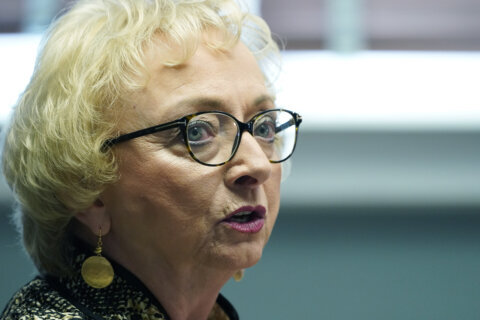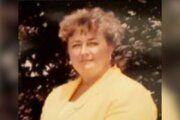Gov. Larry Hogan urged everyone in Maryland who is eligible for a booster shot to get one during a Thursday news conference on the state’s COVID-19 response. He also stressed that the state has an ample supply of vaccines and other coronavirus resources.
Hogan touted Maryland’s progress on tackling the pandemic, saying it “continues to withstand the delta surge better than just about any state in America.”
Maryland has administered more than 7.9 million COVID-19 vaccines, including to:
- 96.1% of residents 65 or older;
- 83.6% of residents 18 or older;
- 82.6% of residents 12 and older.
The governor also said that last week, Maryland reported the lowest case rate in the nation and that COVID-19 cases now only account for 11% of hospitalizations statewide.
Hogan said his administration was able to achieve these metrics “with strong public health outreach, innovative lottery and scholarship promotions, a relentless focus on equality and without resorting to blanket mandates.”
“We are working to get more of those last remaining 16.4% [of the eligible population] vaccinated while also beginning the administration of booster shots for additional protection,” he added.
Big booster push
The Centers for Disease Control and Prevention approved booster shots for the two-dose Pfizer-BioNTech regimen on Sept. 22, but Hogan lamented that federal guidance on the issue has been “limited, confusing and contradictory.”
Despite this, he said Maryland has spent months building the infrastructure to prepare for boosters — more than 78,000 of which have been administered so far.
“We have both the supply and capacity to administer a booster shot to anyone who needs one,” the governor said.
He estimated that about 500,000 Marylanders are eligible for a Pfizer booster shot.
“To determine your eligibility for a COVID-19 booster shot, the simplest thing to do is look at your vaccination card. If you received your second dose of the Pfizer vaccine at least six months ago … you may qualify for one of the categories which are already approved,” Hogan said.
Those categories are:
- Everyone 65 and older;
- Everyone 18 and older with underlying health conditions;
- Everyone 18 and older whose occupation puts them at increased risk of contracting COVID-19, including first responders and those who work in health care, public transit and grocery stores.
“If you’re in one of these categories, you should strongly consider getting a COVID-19 booster shot immediately,” Hogan said.
All people need to do to get a booster shot is self-attest that they’re eligible, and he emphasized that “no provider should turn anyone away.”
6) PFIZER BOOSTER ELIGIBILITY: pic.twitter.com/dcsKuZHUGy
— Kata D. Hall (@katadhall) September 30, 2021
Meanwhile, the Maryland GoVAX call center is proactively calling and texting eligible Marylanders to explain how they can get a booster shot, with about 30,000 appointments already scheduled.
The state will also be pushing boosters through TV and radio ads, as well as on social media.
And next week, Maryland’s “MyIR Mobile” online immunization site will introduce a QR code to more easily show a person’s vaccination status.
Unlike Pfizer, Moderna has only been approved to provide a booster shot to those who are immunocompromised (due to conditions such as cancer), although Hogan said the White House told him that federal approval for wider usage of Moderna boosters “is expected shortly.”
As for the 280,000 Marylanders who received the Johnson & Johnson single vaccine dose, Hogan said “there is still no federal guidance whatsoever” on a booster, which he admitted is “incredibly frustrating,” but “we’re hopeful that we will see more progress in the next few weeks.”
That includes the possibility of federal authorization of Pfizer vaccines for children ages 5 to 11 by late October.
Monoclonal antibody therapy
In addition to vaccines, Hogan said the state has an “abundant supply” of monoclonal antibody therapy, and he urged anyone who tests positive for COVID to promptly talk to their health care provider about the treatment.
“It’s one of the first things you should consider doing before having to go to the hospital, when by then, it may already be too late,” he said, noting that monoclonal antibody treatments are available at more than 80 facilities statewide.
“We’ve already administered more than 13,000 of these antibody treatments, which have helped us avoid approximately 600 hospitalizations and more than 250 deaths,” Hogan said.
“Many more can be prevented if more patients take advantage of these life-saving therapeutics, which is why state health officials have directed clinicians to take actions to step up their utilization of monoclonal antibodies and make sure that every patient who is qualified for this treatment is offered it,” he said.
Helping hospitals
Hogan also said he is working to address the shortage of health care workers by maximizing “the ability of our hospitals to increase their nursing workforce.”
Last week, the Maryland Department of Health declared that registered nurses who hold an active license in any other state or jurisdiction can provide care in Maryland.
“State health officials are also strongly encouraging hospital systems to utilize nursing students, nursing assistants and physician assistants as force multipliers,” Hogan said.
“Today we are announcing that we will introduce emergency legislation to make some of these reforms permanent so that our hospital systems have the tools they need to respond to future crises,” he added.
Ted Delbridge, executive director of the Maryland Institute for Emergency Medical Services Systems, also spoke at the news conference. He said that while COVID hospitalizations in Maryland remain stable, hospitals along the Eastern Shore and western parts of the state — where vaccination rates are lower — are struggling.
“Without question the people of Maryland are fortunate to have a health care system that has repeatedly proven its resilience. This is a testament to the tens of people who go to work every day in our hospitals, clinics and offices and in the field,” Delbridge said.
“However, those same people are just plain tired of going at more than 100% for so long. Hospital staffing is a challenge, leading to less flexibility to accommodate new surgeons and patients,” he said, urging those who have not been vaccinated to get a shot.
Delbridge also warned that officials are bracing for the upcoming flu season, which last year “was uncharacteristically mild” because many people were still isolating and taking other precautions.
This year, however, “Marylanders unquestionably are back on the go,” Delbridge said.
“People seem less likely to be wearing masks, and we are already seeing more people with an assortment of respiratory illnesses seek medical care.”
Delbridge said that includes respiratory viruses affecting children earlier than usual, although he added that pediatric COVID-19 cases in the state remain low.
In fact, 11 children are currently in Maryland hospitals for COVID-19, along with 797 adults — out of a total of 7,290 patients in hospitals statewide for various reasons.
Harsh words for schools
Hogan cited the low number of pediatric hospitalizations statewide, “which represent just 1.3% of our total COVID hospitalizations,” as proof that schools have safely reopened.
“The very encouraging news is that since the start of the school year, we have seen no surge in statewide COVID metrics. The cases that have occurred in schools represent a very small fraction of cases statewide, and we do not see any kind of increased severity among children,” the governor said.
Hogan has dismissed calls from some county leaders to issue a statewide mask mandate for schools. Instead, he said, “the most important thing that school systems can do right now to limit outbreaks and to prevent needless quarantines is to utilize the robust testing capacity that they’ve been given.”
“For the current school year, we provided $182 million through local school systems specifically for surveillance testing of the student population. And we have now extended the application period for this program to Oct. 10. So far, only 13 of the 24 public school systems are participating,” Hogan said.
“The Maryland Department of Health’s testing program also has an additional 415,800 rapid tests available right now for schools to access. In addition, we have provided over $2.7 billion and emergency federal COVID stimulus funding directly to school systems over the past 18 months in order to keep kids safe. However, nearly $2 billion of this funding still remains unused,” Hogan added.
“There’s no excuse for any school system to fail to take any steps toward keeping their students and teachers safe.”
- Sign up for WTOP alerts
- Latest coronavirus test results in DC, Maryland and Virginia
- Latest vaccination numbers in DC, Maryland and Virginia
Looking for more information? D.C., Maryland and Virginia are each releasing more data every day. Visit their official sites here: Virginia | Maryland | D.C.








